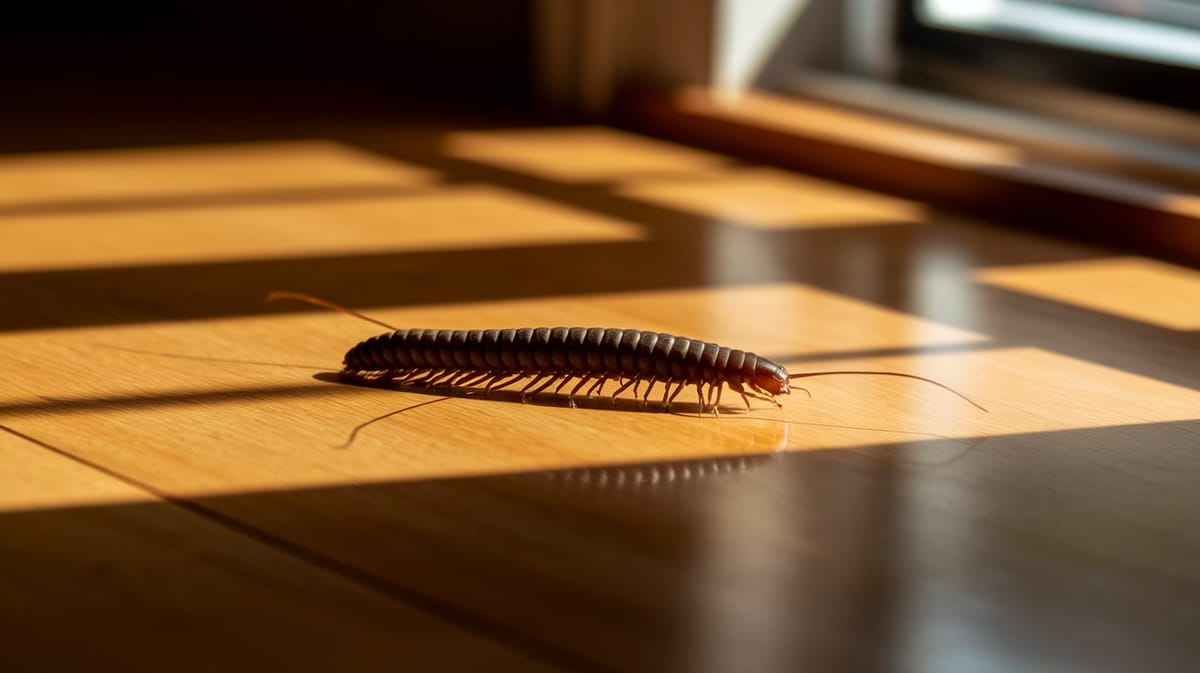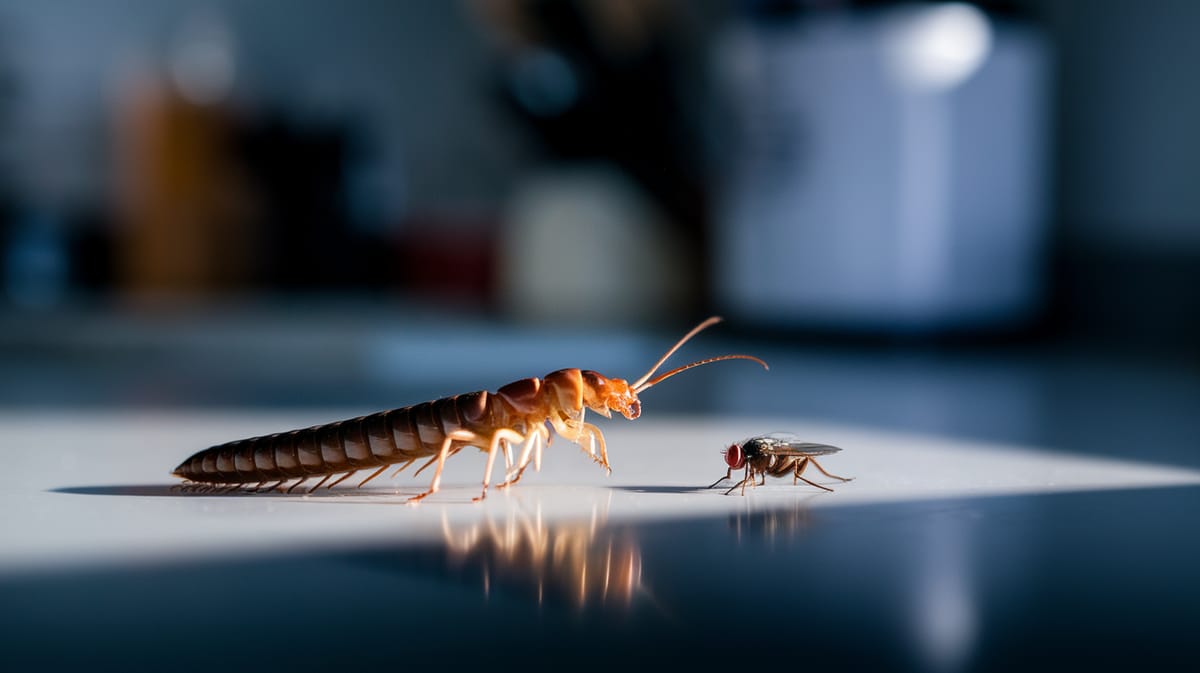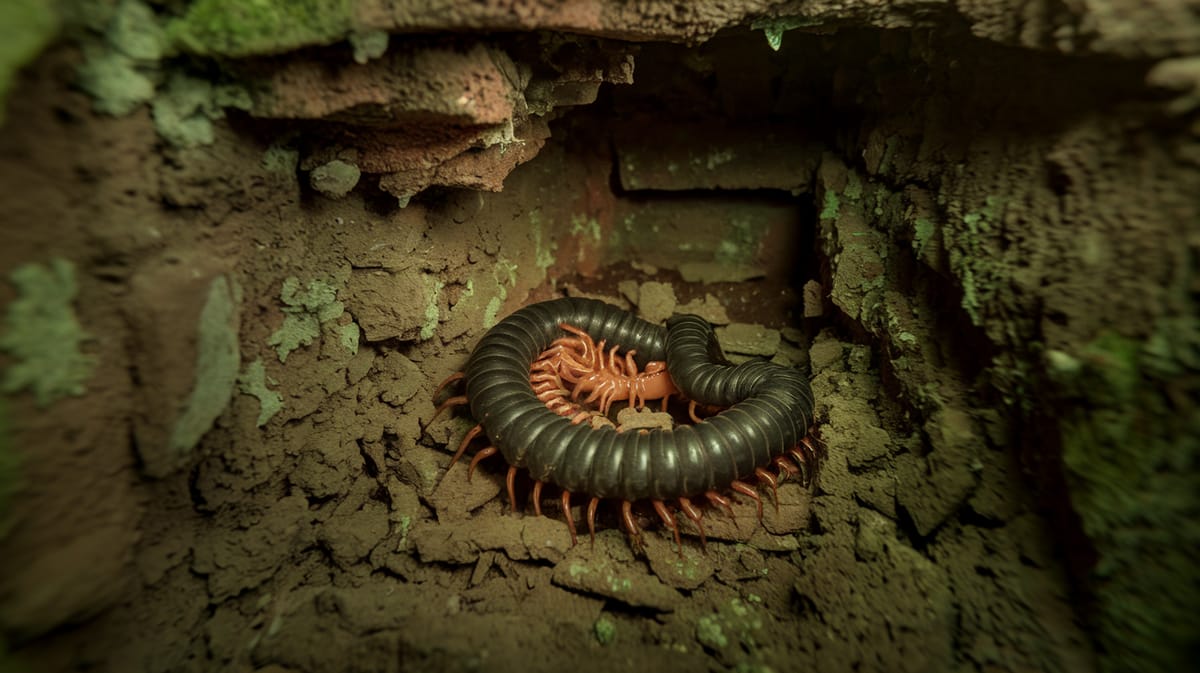House Centipede
With lightning-fast legs and a knack for hunting, the House Centipede silently patrols homes, keeping pest populations in check. Its presence signals a healthy, balanced ecosystem.

Key Insights at a Glance
Did You Know?
Taxonomy & Classification
House centipedes are agile predators, known for their long legs and incredible speed, evolved for efficient hunting in diverse environments. Let's understand the evolutionary journey and classification of these remarkable predators.
Global Presence
The genus Scutigera, including the house centipede, spans across continents, thriving in diverse climates and contributing to ecological balance.
Evolutionary Adaptations
Originating over 400 million years ago, house centipedes have adapted through major climatic shifts, maintaining their role as efficient predators.
Lifecycle and Growth
A remarkable journey of transformation from Egg to Adult.
Egg
Eggs are laid in damp, secluded areas, providing an optimal environment for the developing centipedes to begin their life cycle.
Nymph
Nymphs resemble smaller adults and experience 5-6 molts, gradually gaining more legs and developing their hunting skills.
Adult
As agile predators, adults use their long legs and speed to hunt insects and maintain ecological balance indoors and outdoors.
Dietary Habits
An agile predator with exceptional speed, this insect targets small invertebrates, adapting its diet to available prey in its environment.
| DIET TYPE | DESCRIPTION |
|---|---|
| Primary Diet | Primarily preys on spiders, ants, and cockroaches, using its long legs to swiftly capture and immobilize them. |
| Secondary Diet | Occasionally consumes silverfish, termites, and bed bugs, playing a role in controlling pest populations indoors. |
| Occasional | Rarely feeds on small invertebrates like moth larvae and beetle larvae, exhibiting opportunistic feeding when necessary. |

Behaviour and Adaptations
Discover the fascinating adaptations that make the House Centipede a formidable hunter.
Rapid Leg Movement
With up to 15 pairs of legs, they move swiftly to capture prey.
Sensory Antennae
Long, sensitive antennae help detect vibrations and locate prey.
Venomous Bite
Injects venom to immobilize prey instantly, making capture easier.
Ecosystem Impact
House Centipedes play a crucial role in balancing ecosystems by controlling pest populations and contributing to biodiversity.
Natural Pest Control
Keeps pest populations in check by preying on spiders and insects.
Biodiversity Supporter
Promotes ecosystem diversity by providing food for predators.
Decomposer Partner
Aids in decomposition by breaking down organic matter.
Conservation Challenges
Understanding and addressing the specific threats to House Centipede populations.
Habitat Disturbance
Construction and urbanization disrupt the centipede's natural habitats.
Chemical Exposure
Widespread pesticide use harms centipede populations.
Climate Change
Altered climate patterns affect centipede survival and distribution.
Frequently Asked Questions
How long do House Centipede live?
House Centipedes typically live for about three to seven years. They can survive in various environments as long as they have access to moisture and food sources, such as other insects. Their lifespan allows them to effectively control pest populations.
What do House Centipede eat?
House Centipedes are carnivorous and primarily feed on other insects and arthropods, including spiders, ants, bedbugs, and cockroaches. They are beneficial in controlling household pest populations by preying on these unwanted insects.
Are House Centipede poisonous?
House Centipedes are venomous, not poisonous. They have venomous fangs used to subdue their prey, but their venom is not harmful to humans. Some people might experience mild irritation if bitten, but bites are rare as they tend to avoid human contact.
Are House Centipede endangered?
House Centipedes are not endangered. They are common in many parts of the world and adapt well to human environments. Their ability to thrive in various settings ensures they maintain stable populations without any current threat of endangerment.
What do House Centipede symbolize?
In some cultures, House Centipedes are seen as symbols of protection and pest control due to their role in managing pest populations. They are often viewed positively as natural exterminators, keeping unwanted insects at bay in homes.
Do House Centipede bite?
House Centipedes can bite, but they rarely do so. Their small jaws make it difficult to penetrate human skin, and they generally prefer to flee rather than confront humans. If a bite occurs, it may cause mild irritation or discomfort.
What color are House Centipede?
House Centipedes are typically yellowish-grey with distinctive dark stripes down their bodies and legs. Their coloration helps them blend into their surroundings, allowing them to ambush prey and avoid predators effectively.
Does a House Centipede have wings?
House Centipedes do not have wings. They rely on their numerous long legs for fast and agile movement, which helps them capture prey and escape potential threats. Their leg count and speed are key characteristics of their anatomy.
What does a House Centipede look like?
House Centipedes have elongated, flattened bodies with 15 pairs of long, delicate legs. They measure about 1 to 1.5 inches in length. Their legs and antennae are often longer than their body, aiding in swift movement and sensory perception.
Is a House Centipede an insect?
Technically, House Centipedes are not insects; they are arthropods belonging to the class Chilopoda. Unlike insects, which have three pairs of legs, centipedes have multiple leg pairs. Despite this distinction, they are commonly referred to as insects in casual contexts.
Related Insects
Discover insects with similar characteristics to House Centipede - including shared habitats, diets, and taxonomic classifications
Share this profile
Help others discover House Centipede
